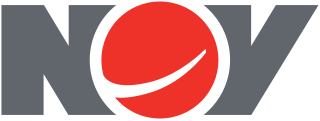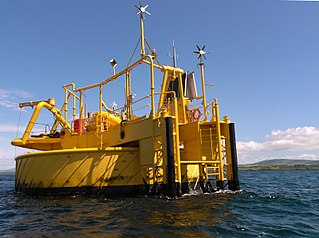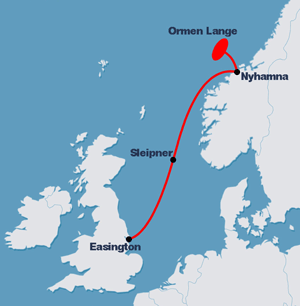
An oil platform is a large structure with facilities to extract and process petroleum and natural gas that lie in rock formations beneath the seabed. Many oil platforms will also have facilities to accommodate the workers, although it is also common to have a separate accommodation platform linked by bridge to the production platform. Most commonly, oil platforms engage in activities on the continental shelf, though they can also be used in lakes, inshore waters, and inland seas. Depending on the circumstances, the platform may be fixed to the ocean floor, consist of an artificial island, or float. In some arrangements the main facility may have storage facilities for the processed oil. Remote subsea wells may also be connected to a platform by flow lines and by umbilical connections. These sub-sea facilities may include one or more subsea wells or manifold centres for multiple wells.

Snorre is an oil and gas field in the Tampen area in the southern part of the Norwegian Sea. The sea depth in the area is 300 to 350 metres. Snorre has been operational since August 1992. It was the first field developed by Saga Petroleum.

In petroleum and natural gas extraction, a Christmas tree, or tree, is an assembly of valves, casing spools, and fittings used to regulate the flow of pipes in an oil well, gas well, water injection well, water disposal well, gas injection well, condensate well, and other types of well.

A drillship is a merchant vessel designed for use in exploratory offshore drilling of new oil and gas wells or for scientific drilling purposes. In recent years the vessels have been used in deepwater and ultra-deepwater applications, equipped with the latest and most advanced dynamic positioning systems.

NOV Inc., formerly National Oilwell Varco, is an American multinational corporation based in Houston, Texas. It is a worldwide provider of equipment and components used in oil and gas drilling and production operations, oilfield services, and supply chain integration services to the upstream oil and gas industry. The company conducts operations in more than 500 locations across six continents, operating through three reporting segments: Rig Technologies, Wellbore Technologies, and Completion & Production Solutions.

A blowout preventer (BOP) is a specialized valve or similar mechanical device, used to seal, control and monitor oil and gas wells to prevent blowouts, the uncontrolled release of crude oil or natural gas from a well. They are usually installed in stacks of other valves.

In the oil and gas industry, coiled tubing refers to a long metal pipe, normally 1 to 3.25 in in diameter which is supplied spooled on a large reel. It is used for interventions in oil and gas wells and sometimes as production tubing in depleted gas wells. Coiled tubing is often used to carry out operations similar to wirelining. The main benefits over wireline are the ability to pump chemicals through the coil and the ability to push it into the hole rather than relying on gravity. Pumping can be fairly self-contained, almost a closed system, since the tube is continuous instead of jointed pipe. For offshore operations, the 'footprint' for a coiled tubing operation is generally larger than a wireline spread, which can limit the number of installations where coiled tubing can be performed and make the operation more costly. A coiled tubing operation is normally performed through the drilling derrick on the oil platform, which is used to support the surface equipment, although on platforms with no drilling facilities a self-supporting tower can be used instead. For coiled tubing operations on sub-sea wells a mobile offshore drilling unit (MODU) e.g. semi-submersible, drillship etc. has to be utilized to support all the surface equipment and personnel, whereas wireline can be carried out from a smaller and cheaper intervention vessel. Onshore, they can be run using smaller service rigs, and for light operations a mobile self-contained coiled tubing rig can be used.

A well intervention, or well work, is any operation carried out on an oil or gas well during, or at the end of, its productive life that alters the state of the well or well geometry, provides well diagnostics, or manages the production of the well.
The Andrew oilfield is a relatively small hydrocarbon field in the UK sector of the North Sea, 230 kilometres (140 mi) North-East of Aberdeen and it is operated by BP. It is produced from a single platform, which is also the hub of the Kinnoull, Cyrus and Farragon subsea developments.

A Single buoy mooring (SrM) is a loading buoy anchored offshore, that serves as a mooring point and interconnect for tankers loading or offloading gas or liquid products. SPMs are the link between geostatic subsea manifold connections and weathervaning tankers. They are capable of handling any tonnage ship, even very large crude carriers (VLCC) where no alternative facility is available.

Q4000 is a multi-purpose oil field construction and intervention vessel ordered in 1999 by Cal Dive International, and was built at the Keppel AmFELS shipyard in Brownsville, Texas for $180 million. She was delivered in 2002 and operates under the flag of the United States. She is operated by Helix Energy Solutions Group. The original Q4000 concept was conceived and is owned by SPD/McClure. The design was later modified by Bennett Offshore, which was selected to develop both the basic and detailed design.

A drilling riser is a conduit that provides a temporary extension of a subsea oil well to a surface drilling facility. Drilling risers are categorised into two types: marine drilling risers used with subsea blowout preventer (BOP) and generally used by floating drilling vessels; and tie-back drilling risers used with a surface BOP and generally deployed from fixed platforms or very stable floating platforms like a spar or tension leg platform (TLP).
Roncador oil field is a large oil and gas field located in the Campos Basin, 125 km (78 mi) off the coast of Brazil, northeast from Rio de Janeiro. It covers a 111 km2 (43 sq mi) area and reaches depths between 1,500 and 1,900 metres.
Riserless Light Well Intervention (RLWI) enables the petroleum operators to increase the oil and gas recovery rate from subsea oil wells. The operation is performed through smaller dynamic positioned monohull vessels instead of larger mobile installations like traditional semisubmersible drilling rigs or drillships.

Commercial offshore diving, sometimes shortened to just offshore diving, generally refers to the branch of commercial diving, with divers working in support of the exploration and production sector of the oil and gas industry in places such as the Gulf of Mexico in the United States, the North Sea in the United Kingdom and Norway, and along the coast of Brazil. The work in this area of the industry includes maintenance of oil platforms and the building of underwater structures. In this context "offshore" implies that the diving work is done outside of national boundaries. Technically it also refers to any diving done in the international offshore waters outside of the territorial waters of a state, where national legislation does not apply. Most commercial offshore diving is in the Exclusive Economic Zone of a state, and much of it is outside the territorial waters. Offshore diving beyond the EEZ does also occur, and is often for scientific purposes.
The Lower Riser Package is a mechanical device to protect an oil well located underwater (subsea) and used during an oil well intervention. The LRP is essentially a mini blow out preventer (BOP). The lower riser package consists of a connector to the subsea oil well, a series of safety valves and a connection point at the top for connection to the riser pipe. The riser pipe is essentially a mini Marine riser and has a maximum inside diameter of 7 inches. A marine riser has a maximum inside diameter of 19 inches.
The Helix fast-response system (HFRS) is a deep-sea oil spill response plan licensed by HWCG LLC, a consortium of 16 independent oil companies, to respond to subsea well incidents. Helix Energy Solutions Group designed the Helix fast-response system based on techniques used to contain the 2010 Gulf of Mexico oil spill. On February 28, 2011 the drilling moratorium imposed as a result of the spill ended when the United States Department of the Interior approved the first drilling permit based on the availability of the HFRS to offshore oil companies.

A submarine pipeline is a pipeline that is laid on the seabed or below it inside a trench. In some cases, the pipeline is mostly on-land but in places it crosses water expanses, such as small seas, straits and rivers. Submarine pipelines are used primarily to carry oil or gas, but transportation of water is also important. A distinction is sometimes made between a flowline and a pipeline. The former is an intrafield pipeline, in the sense that it is used to connect subsea wellheads, manifolds and the platform within a particular development field. The latter, sometimes referred to as an export pipeline, is used to bring the resource to shore. Sizeable pipeline construction projects need to take into account many factors, such as the offshore ecology, geohazards and environmental loading – they are often undertaken by multidisciplinary, international teams.
Alvheim Field is a Norwegian oil and gas field located in the northern part of the North Sea near the border with the British sector, consisting mainly of Boafält, Kneler Field and Kameleon Field. Parts of the Boafält are located in the British sector at block 9/15. The reservoir consists of early-tier sandstone. The depth of the area is 120–130 meters. The production ship is located approximately 12 km west of Heimdal Gassenter, at 59.56684°N 1.99731°E.












